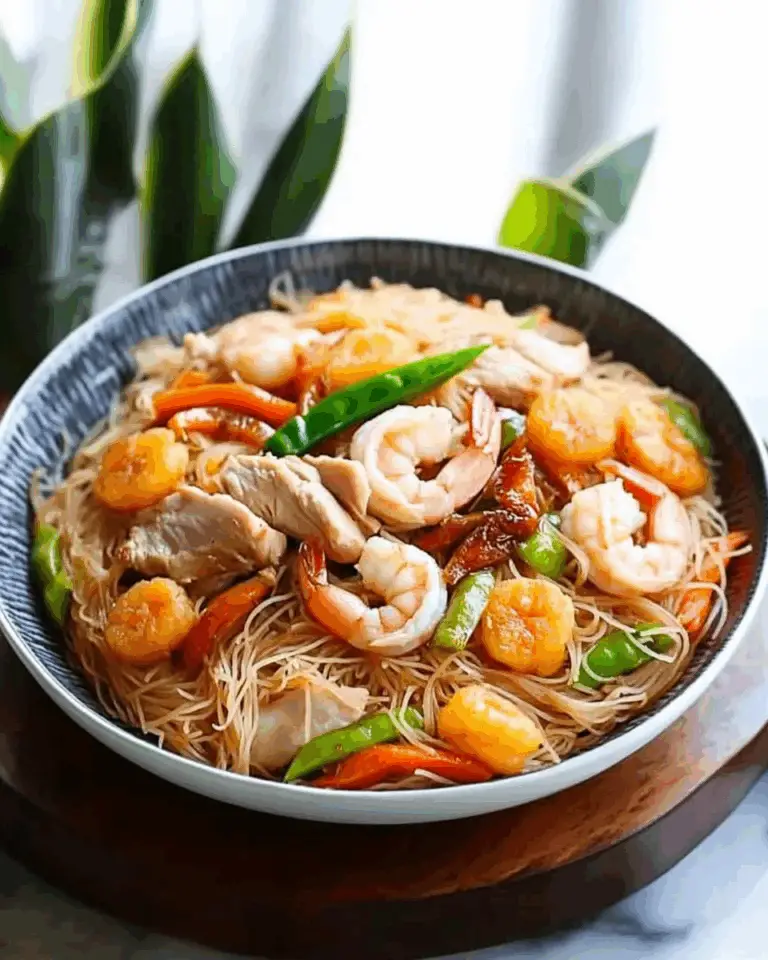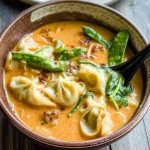Why Pancit Bihon is Always a Crowd Favorite
One of the reasons Pancit Bihon has remained a favorite across Filipino households is its versatility. It can be customized to suit what’s available in your fridge or pantry—add more vegetables for a healthier version, skip the shrimp if you’re on a budget, or load it up with a mix of meats for a more indulgent take. At its core, Pancit Bihon is a forgiving dish that welcomes personal interpretation without straying from its comforting roots.
The appeal also lies in the texture. The rice noodles absorb all the savory sauce, becoming infused with the umami-rich flavors of soy, oyster, and fish sauces while maintaining a light and slightly chewy bite. The combination of tender chicken, succulent shrimp, crisp carrots, and cabbage creates a beautiful harmony in both flavor and mouthfeel.
Pancit Bihon also embodies the perfect balance—salty, slightly sweet, and brimming with umami from the sauces. A quick squeeze of calamansi or lime at the end adds brightness and acidity that lifts the entire dish. It’s this thoughtful layering of flavors that makes each plate of Pancit Bihon feel like a celebration.
The Cultural Significance of Pancit in Filipino Life
In Filipino culture, noodles are not just food—they’re a symbol. Long noodles, especially those used in Pancit Bihon, are associated with long life and prosperity. This symbolism explains why pancit dishes are always present at birthdays and festive occasions. Serving Pancit Bihon during gatherings isn’t just about feeding guests; it’s a quiet wish for health, happiness, and longevity.
Beyond special occasions, Pancit Bihon is a weekday lifesaver in many households. It’s quick to cook, affordable to prepare, and easy to scale up or down depending on the number of people eating. Served with a side of bread or wrapped in banana leaves for packed lunches, it’s just as delicious cold as it is hot, making it ideal for leftovers or meal prep.
A Nutrient-Rich, Balanced Meal in a Bowl
Pancit Bihon isn’t just about taste—it’s a nutritionally balanced dish when prepared thoughtfully. With lean protein from chicken and shrimp, fiber-rich vegetables like cabbage and carrots, and rice noodles that offer energy-sustaining carbohydrates, each serving offers a well-rounded meal that doesn’t compromise on flavor.
The modest use of oil and the option to adjust sodium levels by moderating the sauces means you can make Pancit Bihon suit various dietary preferences. It’s a naturally gluten-free dish when made with pure rice noodles and can be adapted for pescatarians or even vegetarians with simple substitutions like tofu and mushroom sauce in place of meats and fish sauce.
Tips for Mastering the Perfect Pancit Bihon
Success with Pancit Bihon lies in timing and technique. Soaking the rice noodles just until pliable prevents them from overcooking or turning mushy in the pan. Using long cooking chopsticks or tongs while stir-frying helps keep the noodles intact and evenly coated in sauce without breaking them apart.
Prepping all ingredients before you start cooking—mise en place—is essential for a smooth cooking experience. The stir-fry process moves quickly, so having your aromatics, proteins, veggies, and sauces ready ensures everything cooks evenly without burning or oversteaming.
Balance is the name of the game when seasoning. Soy sauce provides saltiness, oyster sauce lends sweetness and body, and fish sauce gives that deep, signature umami flavor that makes Filipino dishes uniquely crave-worthy. Taste and adjust as you go, keeping in mind that a little goes a long way with these strong sauces.
Serving Suggestions and Variations
Pancit Bihon is traditionally served hot, garnished with fresh scallions and a wedge of calamansi or lime. The acidity cuts through the savory richness and brightens the overall flavor profile. For those who love a little heat, a side of chili oil or sliced red chilies in soy sauce is a welcome addition.
You can pair Pancit Bihon with fried spring rolls (lumpia), grilled meats, or a simple egg omelet for a full Filipino-style meal. It also works well as a stand-alone dish—especially when topped with a few extra shrimp or a handful of crunchy garlic bits for garnish.
As for variations, the possibilities are endless. Swap the chicken for pork, or make a seafood-only version with squid and mussels. Add green beans, snap peas, or bell peppers for more color and crunch. For a vegetarian version, use firm tofu and a soy-based seasoning blend.
You can even go bold by turning it into Pancit Bihon Guisado—a saucier take that includes more broth and is perfect for spooning over rice. Though it may seem unconventional to serve noodles with rice, it’s a beloved Filipino carb-on-carb tradition that speaks to the cuisine’s layered comfort.
Conclusion
Pancit Bihon is much more than a quick stir-fry—it’s a celebration of flavor, culture, and community. With its easy-to-make method, budget-friendly ingredients, and crowd-pleasing taste, this dish represents everything that makes Filipino food so beloved around the world. It’s a dish of memories and milestones, of everyday comfort and festive joy.
Whether you’re serving it at a family reunion, packing it for lunch, or making it for a simple dinner at home, Pancit Bihon never fails to satisfy. Its simplicity is its strength, and its flavor tells a story that spans generations. Keep it classic or make it your own—either way, Pancit Bihon is a dish you’ll return to time and time again.






